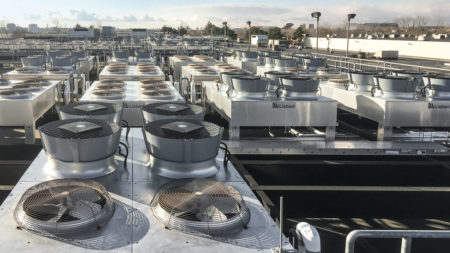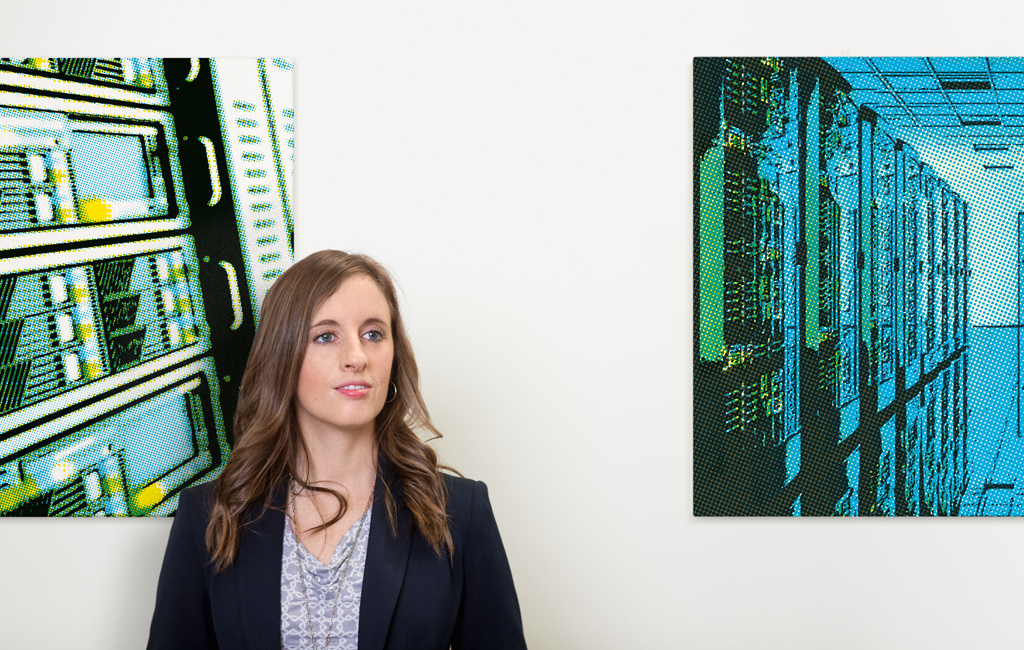r Danielle Owen, sound planning and detailed analysis are the essence of her work: key factors for the success of all her projects. Owen is Director of Business Development Engineering at energy service provider ENGIE Services U.S. (formerly OpTerra Energy Services). Her work consists of showing clients opportunities for saving energy in the management of all types of buildings — whether involving air conditioning, lighting or heating. A project for a major operator of colocation data centers started with a detailed infrastructure review. “Our client has data centers at over 40 sites throughout the US,” says Owen. “They wanted to know from us what measures would be the most worthwhile, and where.”

Danielle Owen of ENGIE Services U.S. knows: The air conditioning of a data center is an art in itself. (Photo | Jake Belcher)
Owen and her team set about analyzing electricity bills, existing hardware and software configurations, and consumption data from all the computer centers. They compared this data against the energy prices and energy-saving programs in the different states. “There’s enormous variation here, so it’s important to know exactly what rebates are available for energy-saving projects in which states, and how to get them.” ENGIE identified three data centers where modifications for greater energy efficiency would especially pay off, with one based in the US state of New Jersey. And then the work really got under way.
Careful examination
ENGIE collected further data on-site, taking a closer look at the existing hardware, as well as the control system. Proceeding on this basis, the company developed a proposal that encompassed a range of passive and active measures for cooling the data center, in addition to replacing all lights. ENGIE backed up the entire plan with figures documenting the expected savings. “This step is particularly important on projects where we’re applying for rebates on behalf of our client,” explains Owen. “The entire proposal including all figures undergoes scrutiny by an independent third party ahead of the project. And even after approval of the subsidy, it will be paid out only when the savings are actually achieved later on.”
“In our projects, we have to back up all measures with hard data of the expected savings. All numbers are checked for their accuracy even after the project is done.”
Danielle Owen, Director of Business Development Engineering at ENGIE Services U.S.
Once the project had been authorized by both the client and the auditing agency, ENGIE’s installation teams got down to business, implementing different measures in parallel. First, the lighting system throughout the data center was switched to LED lights. Improving the air flow through the center was a bit more complex. ENGIE made use of both active and passive measures here.

Active floor tiles are each equipped with four EC fans, which selectively channel cold air from the underfloor at specific points to the server racks. (Photo | Jake Belcher)
The passive measures included setting up cold aisles and fitting barriers that were installed wherever partially filled server racks would otherwise result in gaps in the cold aisles. The most important active measure was the introduction of so-called active floor tiles. These perforated floor panels feature fan trays each equipped with four EC fans, which selectively channel cold air from the underfloor at specific points to the server racks. All told, 324 of these elements were installed by ENGIE in the data center.
Tailored to needs
“Controlling the air flow through a data center is an art in itself,” explains Owen. “Particularly data centers with lots of customers result in a huge variation in loads, which are also distributed over the building’s footprint. Investing in active floor tiles pays off here because they can be used to control the air flow far more precisely, allowing us to switch off consumption heavy air conditioners.” To make this process as efficient as possible, ENGIE equipped each floor tile with three temperature sensors which, like the Computer Room Air Conditioner (CRAC) units, are connected to the building control system.

On the roof, ENGIE replaced old fans with 224 energy-efficient EC fans featuring AxiTop diffusers from ebm-papst. (Photo | Jake Belcher)
If the temperatures measured by the sensors are lower than required, the fans in the floor tiles slow down. When a rack starts to get too hot, the fans in the tile speed up again. If this is not sufficient, a nearby CRAC unit is brought out of standby and supplies more cold air. “Installing extra energy consumers in the form of fans may initially sound like a contradiction if you want to save energy. But the active floor tiles function so efficiently, using them really pays off,” explains Owen.
While one team of ENGIE’s technicians was busy modernizing the interior of the data center bit by bit without interfering with ongoing operations, another was hard at work on the roof. There they removed the fans in the condensers, replacing them with 224 energy-efficient EC fans featuring AxiTop diffusers from ebm-papst.
Owen comments, “One major advantage of this replacement was the ability of ebm-papst to supply us with fans tailored to the units. The company also delivered small consignments of fans to the work site once a week. That was a great help as our client only gave us limited storage space on site.”
A home for servers
Colocation data centers offer customers a way to install their own server hardware in an optimum infrastructure. Companies without a data center of their own can still store their data securely and on their own hardware. For the operators of colocation data centers, this business model means they need air conditioning systems that offer a fast, efficient and flexible response to different load levels.
Once all measures had been implemented, ENGIE’s staff remained on the spot for a few weeks to commission the systems one by one and fine-tune them. “We adopt a successive approach here, finding the optimum settings for all components step by step. We’re happy to spend time on this, because the details of the settings also decide whether operation will be efficient.”
That there has been a marked rise in efficiency is demonstrated by the figures for the project at the data center in New Jersey: Annually, the operator is now saving 7.3 million kilowatt hours. This means that the modification work will pay for itself in less than two years. Thanks to the improved air flow at the data center it has been possible to put 53 of the 112 air conditioners into hot standby mode. Danielle Owen comments that awareness for improving efficiency is also constantly being reinforced by such projects: “During the last five years, operators have been thinking more and more about the efficiency of their data centers. Improving their efficiency also hits their bottom line directly, and in some cases, can free up capacity to serve more customers.”

Leave a comment